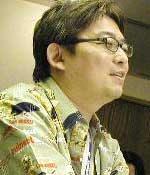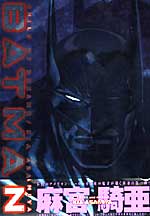
At San Diego ComicCon in July, I was able to speak with the famed mangaka of titles such as "Martian Successor Nadesico," "Silent Moebius" and "Corrector Yui" on the heels of an autograph session he was holding at the Fanboy booth. Fanboy Entertainment Inc. handles the publication of his "Dark Angel" manga by Image comics in the United States. Asamiya's international fame locks into place with Asamiya's cover art for four issues of DC's "New Titans" and the possibility of working with other comics companies on original English language work. But at the moment, his most celebrated project has been the manga version of "Stars Wars: Episode I," a work praised even by George Lucas himself. Near lethargic in a loose fitting button up shirt and shorts, a tired Asamiya and I stroll out to the expansive back patio of the San Diego Convention Center and choose a place to speak overlooking the harbor. As our conversation begins, though, he lights up. Asamiya is an extremely casual man who embraces his profession without being obsessed with it. He likes movies and the beach and Diet Coke ... and his fans. How do you feel that your work has changed from when you first started? Kia Asamiya: I've never thought of that. I've had this same ethic since I first started -- I want to do something that no one else has ever done and I want to keep changing. Over the years do you feel that you've improved more as an artist or more as a storyteller? KA: I've never thought I was good at either. It's a very difficult question. Why do you feel people like your work? KA: I don't know. I'm really thankful for all the fans and happy to have all of them respond to my work. I listen to my fans, pay attention to what they're saying, and try to answer them. I study every day and constantly try new things to grow and develop my work. It's said that the anime and manga industry is waning due to the low birth rate and anime being mainly a kid's market. Do you see your work and the work of other people aimed toward adults, like "Batman," sustaining the industry? KA: Of course since the birth rate is going down the market has been affected; for manga it's a pretty serious problem. I'd like to do something about it but I haven't come up with an idea yet. Considering your affection for American comic books, and the America market as a possible answer to the longevity of manga and anime, do you feel that you might want to start responding to American fans more in the creation of your manga? KA: Fans are fans, no matter what the country is. I treat them equally, I love them equally; anything a fan says that reaches my ears, I try to do the best I can. Actually, I hear more from American fans nowadays than the Japanese fans. Maybe it's because Japanese people are shy. But more than that, American people speak out for themselves.
I know that you embrace the darker incarnation of Batman in your manga, the one that grew out of the mid-80s. But for inspiration, do you ever read some of those old "Batman" comics from the 50s and 60s that had a lighter tone? KA: The ones with aliens and stuff, right. Space aliens, Bat-gizmos? Yeah. The American TV show "Batman," the campy one, drew from what everybody expected the comic to be. But in the 80s, especially under Frank Miller, "Batman" became very, very dark. KA: When I made my own "Batman" of course I read some of the recent ones but I also went back to the golden age and silver age "Batman." While I read "Batman" from every era, I feel the history of the character and how fans respect and love the character. |
||||||||


